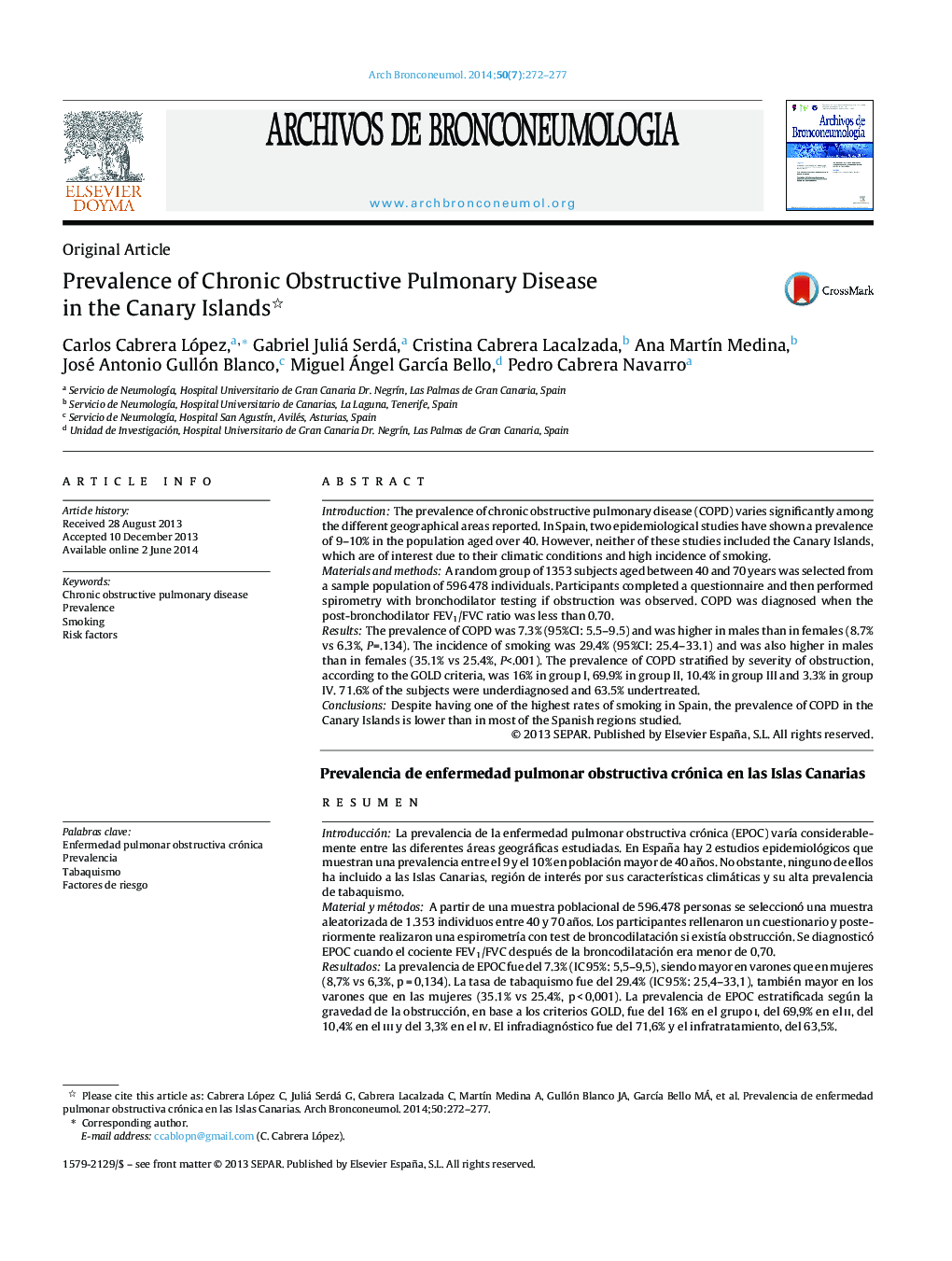| کد مقاله | کد نشریه | سال انتشار | مقاله انگلیسی | نسخه تمام متن |
|---|---|---|---|---|
| 4205602 | 1279920 | 2014 | 6 صفحه PDF | دانلود رایگان |

IntroductionThe prevalence of chronic obstructive pulmonary disease (COPD) varies significantly among the different geographical areas reported. In Spain, two epidemiological studies have shown a prevalence of 9–10% in the population aged over 40. However, neither of these studies included the Canary Islands, which are of interest due to their climatic conditions and high incidence of smoking.Materials and methodsA random group of 1353 subjects aged between 40 and 70 years was selected from a sample population of 596 478 individuals. Participants completed a questionnaire and then performed spirometry with bronchodilator testing if obstruction was observed. COPD was diagnosed when the post-bronchodilator FEV1/FVC ratio was less than 0.70.ResultsThe prevalence of COPD was 7.3% (95%CI: 5.5–9.5) and was higher in males than in females (8.7% vs 6.3%, P=.134). The incidence of smoking was 29.4% (95%CI: 25.4–33.1) and was also higher in males than in females (35.1% vs 25.4%, P<.001). The prevalence of COPD stratified by severity of obstruction, according to the GOLD criteria, was 16% in group I, 69.9% in group II, 10.4% in group III and 3.3% in group IV. 71.6% of the subjects were underdiagnosed and 63.5% undertreated.ConclusionsDespite having one of the highest rates of smoking in Spain, the prevalence of COPD in the Canary Islands is lower than in most of the Spanish regions studied.
ResumenIntroducciónLa prevalencia de la enfermedad pulmonar obstructiva crónica (EPOC) varía considerablemente entre las diferentes áreas geográficas estudiadas. En España hay 2 estudios epidemiológicos que muestran una prevalencia entre el 9 y el 10% en población mayor de 40 años. No obstante, ninguno de ellos ha incluido a las Islas Canarias, región de interés por sus características climáticas y su alta prevalencia de tabaquismo.Material y métodosA partir de una muestra poblacional de 596.478 personas se seleccionó una muestra aleatorizada de 1.353 individuos entre 40 y 70 años. Los participantes rellenaron un cuestionario y posteriormente realizaron una espirometría con test de broncodilatación si existía obstrucción. Se diagnosticó EPOC cuando el cociente FEV1/FVC después de la broncodilatación era menor de 0,70.ResultadosLa prevalencia de EPOC fue del 7.3% (IC 95%: 5,5–9,5), siendo mayor en varones que en mujeres (8,7% vs 6,3%, p = 0,134). La tasa de tabaquismo fue del 29.4% (IC 95%: 25,4–33,1), también mayor en los varones que en las mujeres (35.1% vs 25.4%, p < 0,001). La prevalencia de EPOC estratificada según la gravedad de la obstrucción, en base a los criterios GOLD, fue del 16% en el grupo i, del 69,9% en el ii, del 10,4% en el iii y del 3,3% en el iv. El infradiagnóstico fue del 71,6% y el infratratamiento, del 63,5%.ConclusionesA pesar de tener una de las tasas de tabaquismo más altas de España, la prevalencia de EPOC en las Islas Canarias es menor que en la mayoría de las zonas españolas estudiadas.
Journal: Archivos de Bronconeumología (English Edition) - Volume 50, Issue 7, July 2014, Pages 272–277